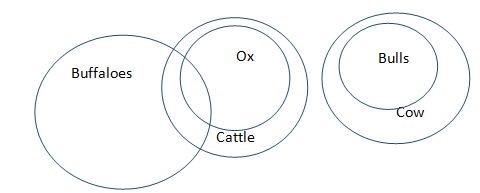Question
Statements: All bulls are cows. No
cow is ox. Some ox are buffaloes All ox are cattle Conclusion: I. Some cattle are ox. II. Some cows are bulls. III. Some buffaloes are cows. IV. Some ox are bulls. In each question below some statements followed by four conclusions numbered I, II, III and IV are given. You have to take the three given statements to be true even if they seem to be at variance with commonly known facts and then decide which of the given conclusions logically follows from the two given statements, disregarding commonly known facts.Solution
All ox are cattle(A) ⇒ Conversion ⇒ Some cattle are ox(I). Hence conclusion I follows. All bulls are cows(A) ⇒ Conversion ⇒ Some cows are bulls(I). Hence conclusion II follows. No cow is ox(E) + Some ox are buffaloes(I) ⇒ Some buffaloes are not cows(O*). Hence conclusion III does not follow. All bulls are cows(A) + No cow is ox(E) ⇒ No bull is ox(E) ⇒ Convserion ⇒ Some ox are not bull(O). Hence conclusion IV does not follow. ALTERNATE SOLUTION: 
What was the theme for Gita Mahotsav 2024?
Who has been elected as the President of the 79th session of the United Nations General Assembly?
Former Meghalaya CM Donwa Dethwelson Lapang, who passed away in 2025, began his political career by winning which Assembly seat?
Recently a “friendship hospital'' has been handed over to which country by India?
Which of the following statements is TRUE regarding the RBI's Prompt Corrective Action (PCA) framework for Urban Cooperative Banks (UCBs) effective from...
When will the additional 25% U.S. tariff on Indian imports, announced by Donald Trump, take effect?
How much does India plan to spend on biodiversity and conservation from 2025 to 2030?
Consider the Following states about “Anchal Abhiyan”:
I. This Abhiyan has been launched in Haryana.
II. The Abhiyan is about...
Who is the convenor of the GST Council's Group of Ministers (GoM) tasked with reviewing insurance GST rates?
If a Panchayat is dissolved, elections must be held within how many months?


